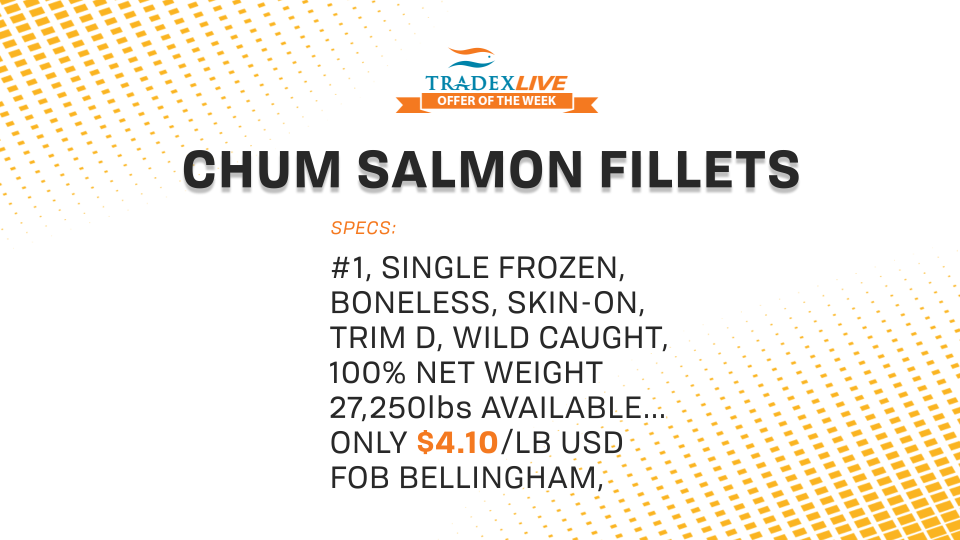
Loading
EP 449 | AIRED 08/05/2019
3MMI - How Climate Change Is Affecting The Alaska Seafood Industry
August 5, 2019 --- In this week's episode we investigate the effects of climate change on the seafood industry. As this topic has a global impact we begin with the effects of climate change on the Alaska Seafood Industry.
2019 Alaska Salmon Commercial Harvest Counter
(Harvest in thousands of fish)
| Chinook 211 |
Chum 10,364 |
Coho 822 |
Pink 40,977 |
Sockeye 52,087 |
Total 105,461 |
|---|
Updated: August 8, 2019 9:00am (View Previous Weeks Totals)
To start this off, we connected with Dr. Kirstin K. Holsman - Research Fishery Biologist at the NOAA/NMFS Alaska Fisheries Science Center.
Here is what she wrote-in about climate change affecting Alaska.
[Dr. Kirstin K. Holsman]: "While many species will be exposed to climate change, what we are learning is that whether a species thrives, declines, or is unaffected by climate change is species specific. In many cases, adaptive and ecosystem-based management like that used to manage ground fisheries in Alaska, reduces the risk of climate-driven declines in fisheries. We are working with the North Pacific Marine Fisheries Council to provide them with the science they need to plan for, predict, and adapt to climate-driven change. Climate change may alter the environment and prey resources for fish and shellfish. Species may respond by moving to more favorable areas, or through staying in place and altering metabolic, foraging, and growth rates. Many species in Alaska are resilient and have tremendous scope for adaptation if they have the opportunity to adapt."
--- Alaska’s marine fish, species distributions, and food webs are increasingly affected by retreating and thinning Arctic summer sea ice, increasing temperatures, and ocean acidification.
Since the early 1980s, annual average arctic sea ice extent has decreased between 3.5 percent and 4.1 percent per decade.
As the climate continues to warm, it is likely that there will be a sea ice-free Arctic during the summer within this century.
Sea ice provides an important surface for algal production and growth in marine ecosystems.
The presence or absence of sea ice affects the transfer of heat, water temperature, and nutrient transport.
Ocean acidification has been shown to affect the growth, survival, sensory abilities, and behaviour of some species, especially species of importance to Alaska, such as Tanner and red king crab and pink salmon.
Studies indicate flatfish, such as the northern rock sole, are sensitive to lowered pH (where a lower pH equates to higher acidity), while Walleye Pollock have not shown adverse effects on growth or survival.
Marine ecosystem food webs are also being affected by climate change.
Changes in sea ice cover and transport of warmer seawater and drifting organisms may be impacting how surface ocean waters interact with the bottom ocean waters.
More than 600 fish species have been found in Alaska waters with an estimated average of $5.9 billion of total economic activity.
In 2018, Salmon alone accounted for 114.5 million fish with an estimated ex-vessel value of $595.2 million.
The distribution of many ocean fish species is shifting northward as the ranges of warmer-water species expand and colder-water species contract in response to rising ocean temperatures.
In fact, Alaska has confirmed the presence of 20 new species and 59 range changes in the last 15 years.
In the Bering Sea, Alaska pollock, snow crab, and Pacific halibut have generally shifted away from the coast and farther from shore.
--- For this piece we reached out to many people at the Alaska Department of Fish & Game, the Environmental Protection Agency, and National Oceanic and Atmospheric Administration to name a few.
It was interesting to note that many were not able to provide an answer.
On responses we did receive, many had to go through high levels of approval and often would take weeks to respond with just a general statement.
I don't believe there is a shortage of climate change research being done however a problem may exist in fisheries managers getting information to the fishermen - who are at the front lines of climate change.
Take a look at The Nature Conservancy's Tidal Change project that documents Alaska Fishermen's concerns on climate change.
Leonard Leach of Ketchikan:
“The environment is changing, undoubtedly. When I first fished there was a lot of ice and now most of the glaciers are all receded. This summer was the weirdest summer of all. It was sun shining the whole summer. If this whole warming trend keeps happening and the ocean starts warming even a few more degrees, my understanding is that jellyfish really come back. They thrive in warmer water and that would be a real detriment to our gillnetting and seining. I mean, jellyfish are a plague they hate. So I believe if somebody comes up with some solutions, and you educate us, we'll do it.”
Bob Eder of Oregon:
“I’m a Dungeness crabber and we’ve already seen effects in that fishery. Warm water produces more algae harmful algae blooms. It’s not something that’s coming, it’s something that we have been experiencing. In our industry there are people of all different political leanings but I don’t think I know any fishermen who don’t recognize climate change and the challenges coming. We are experiencing it.”
Lauri Rootvik of Dillingham:
“Back when I was a child it was the 4th of July run and it was pretty predictable and it’s not predictably the 4th of July anymore. It hasn’t been for quite a few years.”
Lastly, let's end this episode with some comments from Michael Kohan - Seafood Technical Director with the Alaska Seafood Marketing Institute.
[Michael Kohan]: "As a marketing agency for the state of Alaska, we tell the story of Alaska seafood and highlight the gold standard of Alaska’s fisheries management in Alaska’s sustainability story. The management of the fisheries in Alaska integrates an ecosystem-based approach with the best science available to understand how environmental change, including climate change, can inform decision makers to ensure sustainability and resiliency in the ecosystems that support our seafood resources. There are always fluctuations in recruitment populations, changing distribution of the stocks, and other aspects of ecosystem monitoring that are affected by climate variables. Strides have been taken by our Regional Fishery Management Council and fishery scientists to incorporate climate change information into stock assessments which affect fisheries management and policy decisions. However, as most know, Alaska’s geographic location puts us at the front lines of climate change, challenging scientists and managers to develop comprehensive strategies to address our dynamic and rapidly changing fisheries ecosystems. ASMI supports state and federal funding for ongoing data collection to monitor and manage Alaska’s marine resources. In order to address the need for strategies and research around climate change, time series data, monitoring basin to local-scale climate and ecosystem changes over time, not excluding socio-cultural, economic, and traditional knowledge data, needs to be a priority to support the conservation and management of Alaska’s marine resources.
Subscribe to our 3-Minute Market Insight to keep tuned in for when we air more episodes of this climate change series.
--- And finally, our TradexLIVE offer of the week is for IVP Chum Salmon Fillets.
This is a great buy on Single Frozen Alaskan Salmon.
These are 2018 Production, Boneless, Skin-On and 100 percent Net Weight for a sharp price of only $4.10/lb USD FOB Bellingham.
TradexLIVE Offer of the Week

(Click to View Offer)
If you have a topic you'd like to hear on upcoming 3-Minute Market Insights, tweet us on Twitter @TradexFoods




